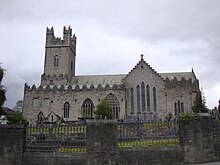St. Mary's Cathedral, Limerick
| Limerick Cathedral | |
|---|---|
| The Cathedral of Saint Mary, Limerick | |
 |
|
| Country | Ireland |
| Denomination | Church of Ireland |
| Website | cathedral.limerick.anglican.org |
| History | |
| Founded | 1168 |
| Dedication | Saint Mary |
| Administration | |
| Diocese | Diocese of Limerick and Killaloe |
| Province | Province of Dublin |
| Clergy | |
| Bishop(s) | Kenneth Kearon |
| Dean | Sandra A. Pragnell |
| Curate(s) | Edna Wakely |
| Laity | |
| Organist/Director of music | Peter Barley |
| Churchwarden(s) | Frank Sheahan (Rector's Churchwarden); Mrs Emma Melin (People's Churchwarden); Noreen Ellerker (Cathedral Sexton). |
| Verger | Craig Copley Brown (Dean's Verger); Avril Gill (Chapter Verger) |
St Mary's Cathedral, Limerick, also known as Limerick Cathedral, is a cathedral of the Church of Ireland in Limerick, Ireland which is dedicated to the Blessed Virgin Mary. It is in the ecclesiastical province of Dublin. Previously the cathedral of the Diocese of Limerick, it is now one of three cathedrals in the United Dioceses of Limerick and Killaloe.
Limerick Cathedral (St Mary's) is dedicated to the Blessed Virgin Mary was founded in 1168 and is the oldest building in Limerick which is in daily use. It has the only complete set of misericords left in Ireland.
In 1111, the Synod of Ráth Breasail decided that "St. Mary's church" would become the cathedral church of the Diocese of Limerick. According to tradition, Domnall Mór Ua Briain, the last King of Munster founded the present cathedral on the site of his palace on King's Island in 1168. The palace had been built on the site of the Viking meeting place, or "Thingmote" – the Vikings' most westerly European stronghold. This had been the centre of government in the early medieval Viking city. Parts of the palace may be incorporated into the present structure of the cathedral, most prominently the great west door, which tradition claims was the original main entrance to the royal palace. The West Door is now only used on ceremonial occasions. The Bishops of Limerick have for centuries knocked on this door and entered by it as part of their installation ceremony. According to tradition, during the many sieges of Limerick the defenders of the city used the stones around the west door to sharpen their swords and arrows, and the marks they made in the stonework can be seen there today.
...
Wikipedia
